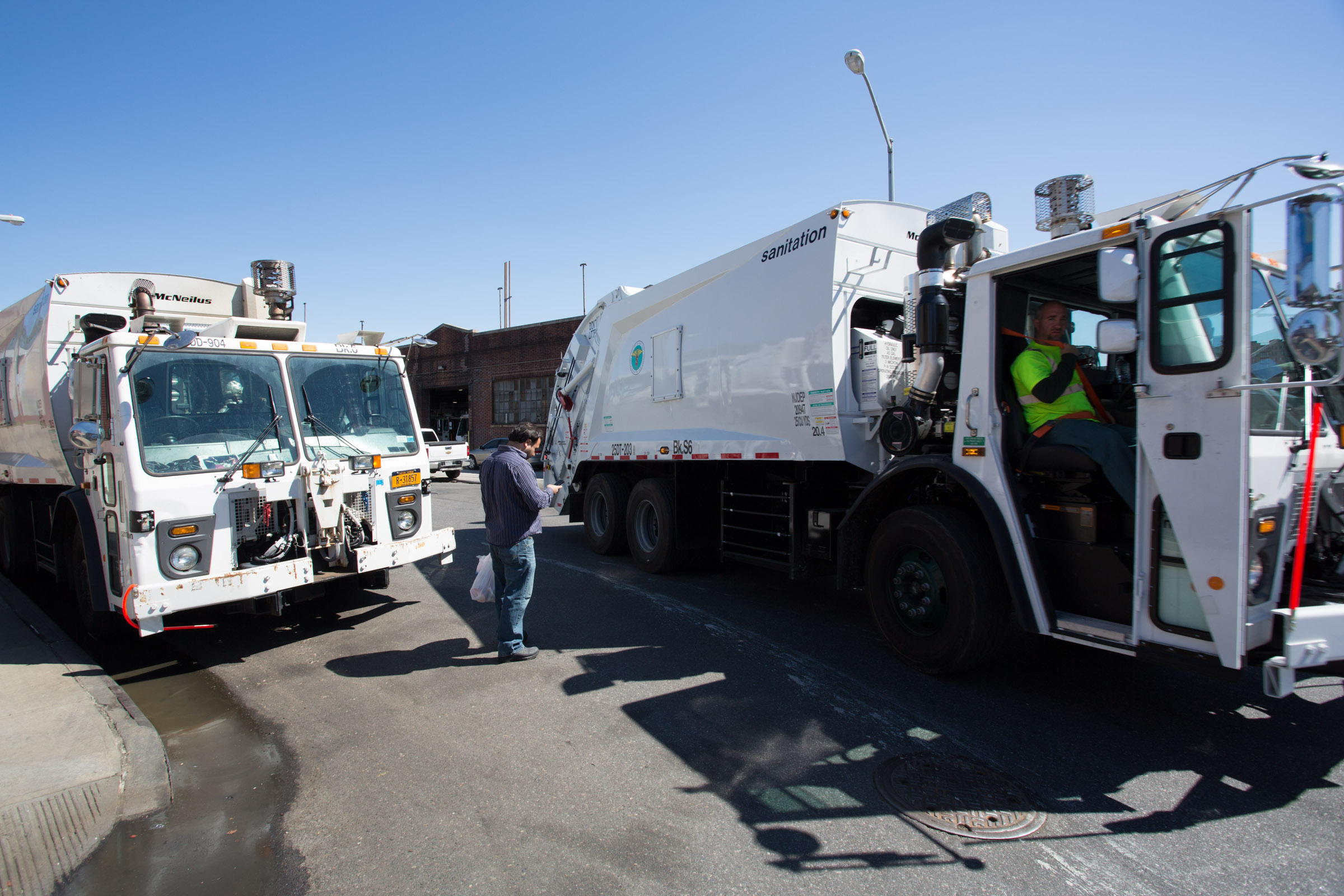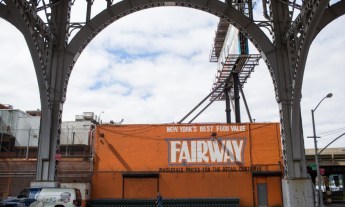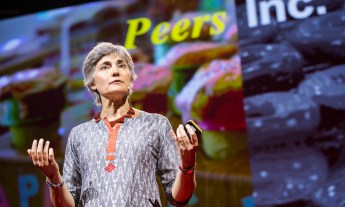
Robin Nagle is anthropologist-in-residence at the Department of Sanitation and longtime resident of New York City. In this interview with Alison Prato, she describes a life dedicated to, well, trash.
In 1982, Robin Nagle moved to New York City from Saranac Lake, in upstate New York, to become an actor. Today, she is the anthropologist-in-residence with the Department of Sanitation in New York (DSNY) and a professor in the anthropology department at NYU. So how does one go from wanting to be the next Meryl Streep to studying garbage?
Via Skype, wearing a tank top that shows off the colorful dragon tattoo on her left shoulder (designed and inked by Ed Hardy), Nagle says that her career trajectory took an unexpected turn in 1987 when, as an undergraduate at NYU, she heard an impassioned talk in a public art class given by Mierle Ukeles, then the artist-in-residence at the DSNY.
“I had discovered anthropology with the same sort of fervor and sense of possibility that a new convert finds in religion,” Nagle says. “When I heard Mierle speaking with such knowledge, care and wisdom, I realized I could be serious about getting to know sanitation as a culture. These were people who deserved better attention than they already got. My questions about them as people were endless.”
“I was too naive to recognize that I was living in a neighborhood that was just dangerous.”
Nagle finished her PhD at Columbia in 1994 and was appointed assistant dean for student affairs and academic services in NYU’s Graduate School of Arts & Science. In 1996, she became the director of NYU’s Draper Interdisciplinary Master’s Program in Humanities and Social Thought, which she still runs. She first started working with the DSNY in 2002, and by 2006 had been appointed its anthropologist-in-residence, an unpaid position that allows her to study, at close range, both sanitation workers and the stuff that New Yorkers throw away on a daily basis. In addition to writing Picking Up: On the Streets and Behind the Trucks With the Sanitation Workers of New York City, which was published by Farrar, Strauss & Giroux in March 2013 (her research included joining the force herself), Robin is working on DSNY archives, an oral history project, and someday, she hopes, even a sanitation museum.
Her first New York City apartment was in an early-’80s loft conversion that had “had no blessing from any bureaucracy.” It was near the main gates of the Brooklyn Navy Yard, on a street that she says “still looks a little hairy.” Across from the loft, homeless people lived in an abandoned chocolate factory where trees grew out of the windows. “They used to light fires by accident, and we’d run up to watch the flames hoping the fire department didn’t come too soon, because the flames were kind of pretty.”
The neighborhood was gritty — and she loved it.
“We were there illegally,” she says of her loft. “But some of the businesses nearby were also doing things that maybe they shouldn’t have been, so we didn’t rat each other out. It was messy. It was transformative. I was too naive to recognize that I was living in a neighborhood that was just dangerous.”
Nagle gave herself a five-year cap on staying in New York. That was 31 years ago. “I’d dreamed of coming here ever since I was a small child. My grandparents lived here for a while. I felt like I was fulfilling my destiny. I figured I had to try New York, and maybe it would chew me up and spit me out, or maybe I’d find another adventure elsewhere.” Instead, she realized the magical thing about the city: It’s constantly evolving, so you never get the same New York twice.
In those three decades, she has lived in Brooklyn’s Park Slope and Manhattan’s Greenwich Village and Upper West Side. Seven years ago, she moved into an apartment in West Harlem because it was affordable, and because she loved how there were families on the street at all times, no matter what the hour.
“When I first moved here, I had an obligation that kept me out very late,” she says. “I took the subway home at 2 a.m., and as I was climbing the steps, I was thinking, ‘I wonder what the walk home is going to be like. It’s really late and really dark.’ I was nervous. But as I came out of the subway, it was like I’d walked into a street fair. Every stoop had people sitting on it. There were old men playing dominos and kids with boomboxes. There were grandmothers dandling babies and ladies gossiping. It was a vibrant scene — not scary in the least. But it’s become more gentrified. Now when I come out of the subway late, there’s nobody on the street. It’s changed a lot for the worse.”
Being privy to foul odors is one of the trappings of her job, but Nagle laughs heartily when asked what her neighborhood smells like. “I live across the street from the North River wastewater treatment plant. So my neighborhood sometimes smells like a fart. Not always, not often, but on a muggy summer day, when the wind is from the south, you know where you are.”

While researching Picking Up, Nagle got certified and spent time behind the wheel of a sanitation truck in the Bronx (out of the 7,000 uniformed “on the street” personnel, only about 200 are women). Her garbage-eye view allowed her to get a better sense of life for the city’s residents.
“There are two primary infrastructural requirements: One is that clean water comes in and dirty water goes out. The other is that the garbage gets picked up off the street.”
She learned, for example, that most New Yorkers tend to either ignore san workers (never “garbagemen” or “garbagewomen,” which are seen as derogatory terms) or have an outright disdain for them.
“People on the job come to understand that New Yorkers — and this is true of people in many other cities too — put garbage out, forget about it, and when they come home, it’s gone. So who does that work? They’re like, ‘Who cares?! It’s gone and I don’t need to worry about it anymore. And if you tell me it’s the garbage fairies, well that’s great. We’ll believe in garbage fairies then!'”
When the public does take notice, she says, the reaction is bluntly negative. “If they pay attention to us at all, it’s not enough to even nod hello. It’s more like, ‘You’re blocking the street! You missed my collection yesterday and you’re on the public dime!’ The presumption on the part of some is that as a sanitation worker, you’re going to screw up, or you’re not too smart, because why would you take that job? Somehow there’s this contagion thing, where you must somehow be garbage-ish yourself, which is absurd, of course.”
The aim of her work isn’t just for people to recognize that san workers are people too. She also argues that it’s a more important job than even police officers and firefighters.
“Saying they’re the most important uniformed force on the street is an intentionally provocative claim,” she says. “I absolutely believe it, and people disagree with me — even people on the job. But if you think about how a metropolis either strives or struggles, either the citizens have a shot of living long, healthy lives, or it’s going to be a daily gamble as to whether or not they’re going to survive. There are two primary infrastructural requirements: One is that clean water comes in and dirty water goes out. The other is that the garbage gets picked up off the street, regularly and efficiently, and that it goes somewhere else so it’s not causing harm to the city’s residents.”
Considering that homes and public institutions in New York produce approximately 10,500 tons of garbage a day — she makes a persuasive argument.
It’s impossible for Nagle not to notice the garbage everywhere she goes, whether she’s walking or biking, her preferred modes of transportation around the city. “I’m thinking, ‘What district is this? Who’s on this basket route? What’s the broom schedule? Did that business separate its recycling? Oh look, it’s alternate side parking, but that car didn’t move and there’s crap underneath, so that piece of the street won’t get clean,'” she says with a laugh. “Always, always, always. I’m a little obsessed.”
Check out all of Nagle’s favorite places in New York in this handy annotated map. To see them in pictures, see a gallery with photographs shot by Ryan Lash. This article was published as part of our “Questions Worth Asking” series. This week’s teaser: “What makes a city feel like home?”
Alison Prato is a regular contributor to TED.












